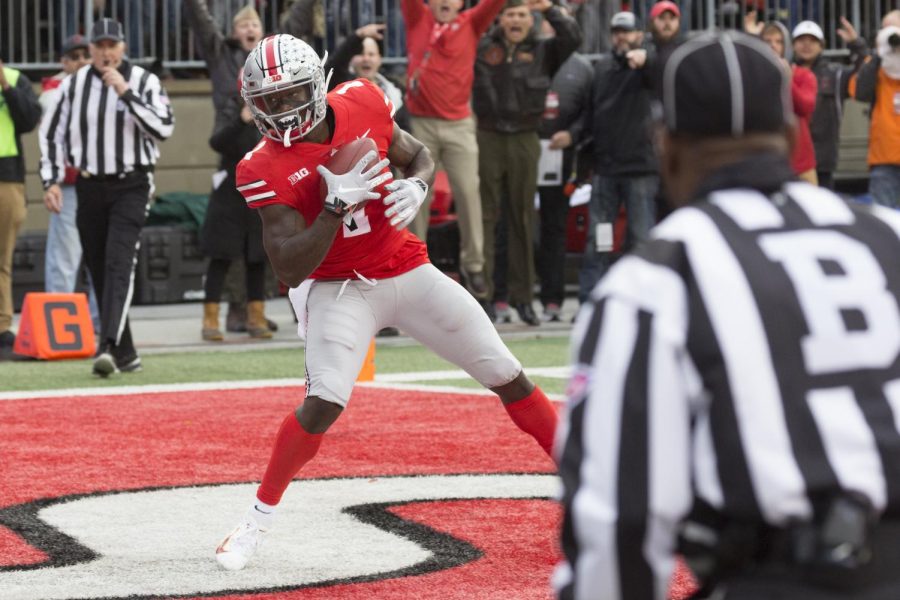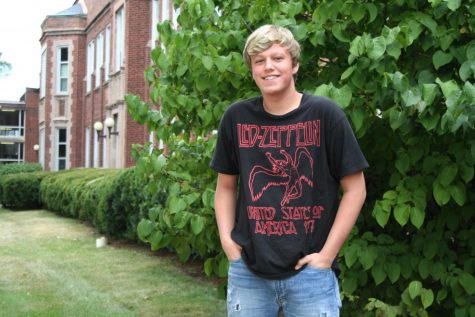2020 NFL draft: what you need to know
Jeffrey Okudah, the top cornerback in this year’s draft class, is projected to go top three. Photo courtesy of Wikimedia Commons.
April 23, 2020
Unlike most events this April, The 2020 NFL Draft will still be taking place from Thursday, April 23 through Saturday, April 25 via a large online meeting with the commissioner, as well as representatives from all 32 teams. Each individual will be working from their respective homes, including the league’s commissioner, Roger Goodell, who is hosting the draft in the basement of his house in New York. Besides the lack of a stage for draftees to walk onto after being drafted and no crowd cheering (or booing) after each selection, the draft itself remains unchanged. Fans will still be able to watch on live television, and the draft will still consist of seven rounds, spread out over three days.
Another constant in this year’s draft is the influx of talent prepared to enter the league from the collegiate level. With four quarterbacks projected in the first round, eight wide receivers in the first two, and yet another Ohio State University (OSU) defensive end projected at number two overall (the second in as many years), this draft could have long-term ramifications on the league like no other has before.
After a season that included Louisiana State University (LSU) taking home their first national championship trophy since 2007, Alabama missing the College Football Playoff (CFP) for the first time in its history, Ohio State losing yet another heartbreaker to Clemson in the CFP semifinal, and a record 115 underclassmen declaring for the draft once the season concluded, it’s safe to say that the offseason left just as many questions as the season.
One area where there isn’t a question mark is the number one overall selection, since for the first time since 2014, most of the sports world has come to a consensus on the first pick: highly regarded quarterback (QB) prospect Joe Burrow out of LSU.
Burrow followed up a very mediocre 2018 campaign in which he completed only 57% of his passes for 2,894 yards and 16 touchdowns, by lighting up the scoreboard in every game of his senior season in 2019, completing over 76% of his passes for 5,671 yards and a whopping 60 touchdowns, a new NCAA record.
The Cincinnati Bengals hold the first pick in this year’s draft, and they are more than ready to find their QB of the future. After nine years with Andy Dalton at the helm of their offense, they’ve had enough mediocrity and are now looking for a new, more electrifying quarterback to bring the Lombardi trophy to Cincinnati for the first time, and all signs are pointing towards Burrow being their guy.
Another quarterback in the 2020 draft class that has a lot of buzz is former Alabama QB Tua Tagovailoa, who would be in the same conversation as Burrow for the number one pick if it wasn’t for Tagovailoa dislocating his hip during a game in mid-november, causing him to miss the remainder of the season. Tua still had another season of eligibility at Alabama, but chose to forgo his senior season where he’d risked getting injured for a third time in as many years, and rather bet on himself and the skill he has showcased over the past two plus seasons. Most mock drafts expect Tagovailoa to be selected fifth overall by the Miami Dolphins, who are in desperate need of a franchise quarterback after starting a 37-year-old Ryan Fitzpatrick in 13 of their 16 games last season.
The two other quarterbacks that have first round potential are Oregon QB Justin Herbert and Utah State QB Jordan Love, both of which had impressive but not overwhelming collegiate careers and are both highly touted due to their size and poise in the pocket. Love is six feet, four inches tall, weighs 225 pounds and is stated by scouts to have the purest throwing form. Herbert is six feet, six inches tall and weighs 238 pounds, which has caused scouts to salivate at just his measurables.
Other notable quarterbacks who could get selected on days two or three of the draft are Oklahoma QB Jalen Hurts, Washington’s Jacob Eason, and Georgia’s former signal caller Jake Fromm. Hurts transferred from Alabama after losing the starting job to Tagovailoa, ended up at Oklahoma and finished second in heisman voting in 2019. Eason transferred from Georgia in early 2018 after losing his grasp of the starting job to Fromm while injured, sat out the 2018 season at Washington and then played one season there, choosing to forgo his senior season as well. Fromm stepped in as the starter for Georgia in 2017 after Eason went down with an injury, and never looked back. He led the Bulldogs to the college football playoff as a freshman, and left Georgia no choice but to start him over Eason in 2018.
The top non-quarterback prospects in the draft include Ohio State edge rusher Chase Young, Clemson linebacker/ safety hybrid Isaiah Simmons, Alabama wide receiver Jerry Jeudy and Ohio State cornerback Jeffrey Okudah.
Young led the NCAA in sacks his junior year with 16.5, despite missing two games due to a suspension handed down by the NCAA for allegedly taking a loan from a family friend in 2018. Young finished third in heisman voting in 2019, and is projected to be picked by the Washington Redskins with the second overall selection.
Simmons is yet another stud to come out of Dabo Swinney’s system at Clemson, and can virtually play every single position on defense, having lined up at linebacker, cornerback, defensive end and safety during his time with the tigers. Many experts and analysts expect the New York Giants to select Simmons with the fourth overall selection this year, due to his ability to contribute at every level on a subpar Giants defense.
Alabama’s Jeudy headlines a loaded class of wide receivers, followed by the likes of fellow Alabama teammate Henry Ruggs III, who ran a 4.27 40 yard dash, and Oklahoma’s CeeDee Lamb, who is said to have the most potential out of the group after spending three years with heisman finalists as his quarterbacks at Oklahoma.
Ohio State’s Okudah broke onto the scene as a junior this year, constantly shutting down the opposing team’s top wide receiver and gaining national attention due to his ability to break up nearly any pass thrown his way. He is projected to be selected third overall by the Detroit Lions. Because Detroit traded away their top cornerback Darius Slay in March, leaving a gaping whole at the position, one may think Okudah could quickly fill it. Florida Cornerback C.J. Henderson has shot up draft boards recently, with there even being discussion of him being drafted in the top 5 along with Okudah, or as an alternative for Okudah.
One position with zero projected first round picks is running back (RB). Georgia RB D’andre Swift is expected to be the first to be drafted, but not until the second or third round of the draft. Swift ran for 1,218 yards in 2019, averaging a solid 6.2 yards-per-carry (YPC). Another RB expected to be drafted in rounds 2-4 is Wisconsin’s Jonathon Taylor. Taylor put on a show during his three seasons at Wisconsin, finishing with 6,174 career rushing yards, 6.7 YPC and 55 total touchdowns, leading the Big Ten conference in rushing yards all three years at Wisconsin in addition to leading the entire NCAA in 2018. Taylor also ran a 4.39 40 yard dash at the NFL combine, leading all running back’s despite being the third heaviest RB in the draft, making his size and speed just one of many reasons that teams view him as one of the top running backs on the board.
The third RB that is projected to go on day two of the draft is Ohio State’s J.K. Dobbins. Dobbins split carries with former OSU running back Mike Weber for his first two seasons, but after Weber declared for the draft in 2019, Dobbins was able to become the feature back in Ohio State’s new offense under head coach Ryan Day, and exploded for 2,250 all purpose yards and 23 total touchdowns, three more than his previous two seasons combined.
While every newspaper, sportswriter and draft analyst can predict the draft for months on end, they all end up meaning nothing come April 23rd, when teams shock everyone and make unexpected moves that shake up the entire draft, and the league for years to come.


